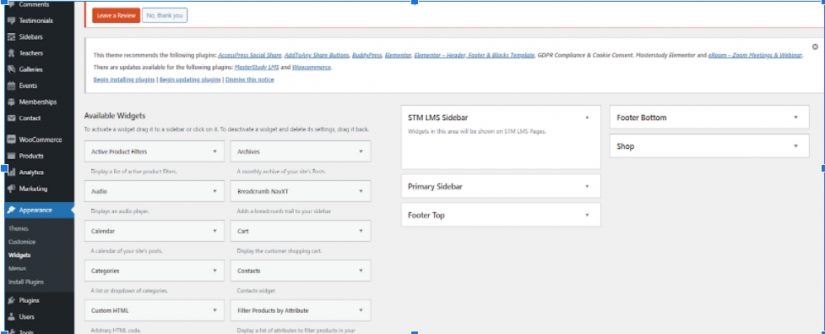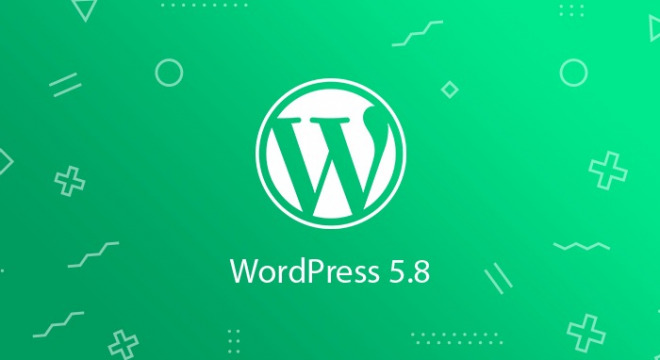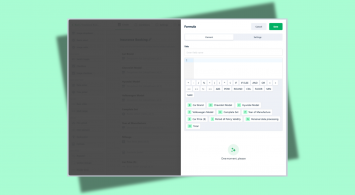One of the biggest updates in this year was the announcement of the new version of WordPress 5.8, which should bring a lot of new to the basic functionality and drastically change the appearance and ways of building sites in specific sections.
In this article, we would like to review the most basic points and features, which are presented.
We prepared in advance for this event and made the new version of the WordPress platform fully compatible with our themes and plugins:
Our Themes:
Our Plugins:
Let’s take a close look at all the new things prepared for us by WordPress team!
Widget Editor
Speaking of the notable changes, one of the most significant features is the overall appearance of the Widgets subsection in the Appearance tab.
Now it looks like a real page builder!
For comparison, this is how the widget window looks in versions 5.7 and below

Old Widget Area
In the new 5.8 version, this section now looks like this one:

New Widget Area
You can now directly insert navigation elements, buttons, gallery, columns and other widgets.
Also, you can now instantly change the properties and parameters of widgets in the right sidebar of this section after selecting a specific widget.

Widget Parameters
This is very convenient in our opinion. No longer have to open a new tab to see the changes on the page. Changes can be tracked directly in the Widgets section.
In case you are not satisfied with the new look of Widgets, you can always bring the old design back by installing and activating Classic Widgets.

Classic Widgets
New Template Editor
In WordPress 5.8 there is a new feature named the template editor.
Now you can create a new template by going to the Template tab on the right sidebar of the page or post and clicking Edit for configuring the current template or create a new one.
After opening the form, you need to name your custom template. After that, WordPress will switch to template editor mode. This will allow us to edit areas that are not relevant to our content.
Below is a list of all the new features that WordPress 5.8 opens up for us. You can add/edit all these elements to your new template.
- Site Logo
- Site Tagline
- Site Title
- Query Loop
- Post Title
- Post Content
- Post Date
- Post Excerpt
- Post Featured Image
- Post Categories
- Post Tags
- Login/out
- Page List
The template editor integrates and works with your theme. It uses the styles of your WordPress theme, so all changes fit neatly into your website design.
Block Editor
For Posts there is an outstanding feature to organise your multiple posts.
This tool Query Loop allows you to place groups of posts in a couple of clicks according to the indicated parameters.
This will greatly simplify the organization of posts. Before you will need to install and use a third party plugin for these actions.

Block Editor
WebP Support
The new version implements the ability to add images in WebP format.
This format was released by Google more than ten years ago.
In brief, WebP format allows you to reduce the size of images by 30% in the mode without loss of quality and by 25-35% with loss of quality.
This has a very positive effect on the overall performance of the website! The quality is in no way inferior to other popular formats and at the same time takes up less physical space.
This means that with a lot of media, the risk of slowing down the speed of the entire website is reduced.
The main problem with the widespread use of this format is that not all browsers and applications can use the WebP format by default and without the help of third-party plugins.
In version 5.8, this format is already included as one of the main ones. Images in this format can now be directly uploaded to your media storage.

WebP image (30 KB)

JPG Image (44 KB)
Mediafiles
The new version has a button for adding files instead of gradually loading when scrolling.
It also increases the overall presentability and speeds up the loading process for all available images.
Duotone Colour Filter for Images and Mediablocks
In addition to the rest of the functions, there is an interesting way to apply tones and various filters on your images from the available eight presets using Duotone technique.
In a nutshell, Duotone allows you to combine a pair of opposite tones, where one of them is black and the other one is light.
Mixing it might give the fascinating immerse effect.

Duotone demonstration
Besides you are able to set the focus on the image, the transparency of the background, the choice of one of two types of gradient, the definition of styles and borders of the image.
There is also the option to create your own custom preset in Duotone. To do this, you need to edit the theme.json file and include your desired set of presets.

All available Duotone presets
Custom Changes
As we mentioned earlier, in this version there is a special theme.json file which is located in the wp-includes folder of your website and will be needed by theme or plugin developers to change styles, blocks, typography and internal structure.

Theme inner style and typography data
Conclusion
Obviously, WordPress is betting in the new version on full editing of pages, posts and appearance without using third-party specialized plugins for this.
A gradual compatibility of many themes and plugins with WordPress 5.8 is expected over time.
In summary, we would like to note again that all our exclusive themes and plugins are already fully compatible with the new version of WordPress.
We hope that the article was interesting to you and you could learn a lot about the new version of WordPress 5.8.
If you have any questions, we are always free to respond to all of them.
You can load the new version directly from official source – https://wordpress.org/download/
See you soon!

































